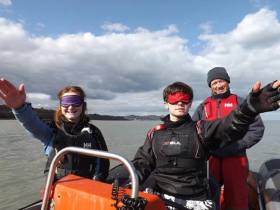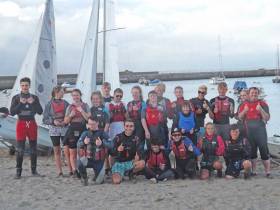Displaying items by tag: Lakers
Bray Sailing Club & Lakers Group Join Forces on Water
Bray Sailing Club’s instructor team for the 2018 sailing season recently spent a day learning about inclusion in sailing with Irish Sailing’s Inclusion Officer, Ciarán Murphy. This training course for the club’s instructors followed last year’s “Try Sailing” courses run by Bray Sailing Club for Lakers members, during which fourteen Lakers members took to the water for the first time.
The inclusion training was an overwhelming success, with the team of instructors learning the theoretical background to Inclusion Sailing in the morning before putting it all into practice on the water in the afternoon. The instructor team experienced what it is like to sail blind, deaf, and by using hand signals, with the use of a blindfold, ear muffs and duct tape respectively. Instructors were also instructed on the correct way to transfer people from shore to boat.
At the conclusion of the course, Bray Sailing Club’s Senior Instructor, Jack Hannon, commented “It has been a great day of fun filled learning, and we really appreciate Ciarán coming out to run the course with us. We have learned a lot which will stand to us going forward this season as we introduce a regular sailing schedule with Lakers members. This just highlights that sailing really is a sport for all and a sport for life!”
Lakers is a local social and recreation club for children and adults with an intellectual disability. As Afloat.ie previously reported, following the introductory sessions of 2017, which included the issue of the first Irish Sailing certificate in Braille, Bray Sailing Club is planning a regular sailing programme for Lakers members in 2018.
Bray Lakers Take To The Sea In ‘Try Sailing’ Initiative
#TrySailing - Bray Sailing Club partnered last week with Lakers, a sport and recreation club for children and adults with an intellectual disability, to offer an introductory ‘Try Sailing’ course to seven Lakers members.
The sailability programme took place over three evenings, starting with a land-based familiarisation session on the first day, during which the newcomers to sailing learned how to rig and sit in a dinghy.
On the second evening, the group took to the water and experienced their first taste of the thrill of sailing inside the confines of Bray Harbour while the cruiser fleet raced with 25+ knots of wind outside. This session was followed by capsize drills near the beach in the harbour.
On the third evening, the dinghy fleet left the harbour and the trainees had a chance to helm their own boat, before heading into the clubhouse for a barbecue and the presentation of Irish Sailing’s Taste of Sailing certificates, including Irish Sailing’s first ever braille sailing certificate.
Speaking after the event, Lakers services manager Anthony Finnegan said: “We really appreciate the contribution of the amazing instructors and assistants in Bray SC in giving our members the opportunity to try sailing for the first time.
“The enthusiasm and excitement evident around the harbour was great to see, and we hope that some of our members will have the opportunity to participate in sailing on a regular basis in the future.”
Bray SC senior instructor Jack Hannon added: “I’m grateful to our team of instructors and assistants who gave of their time so willingly to make this partnership such a success.
“Sailing really is a sport for all, and our members were delighted to have the opportunity to share their passion for sailing with seven newcomers to the sport this week.”






























































